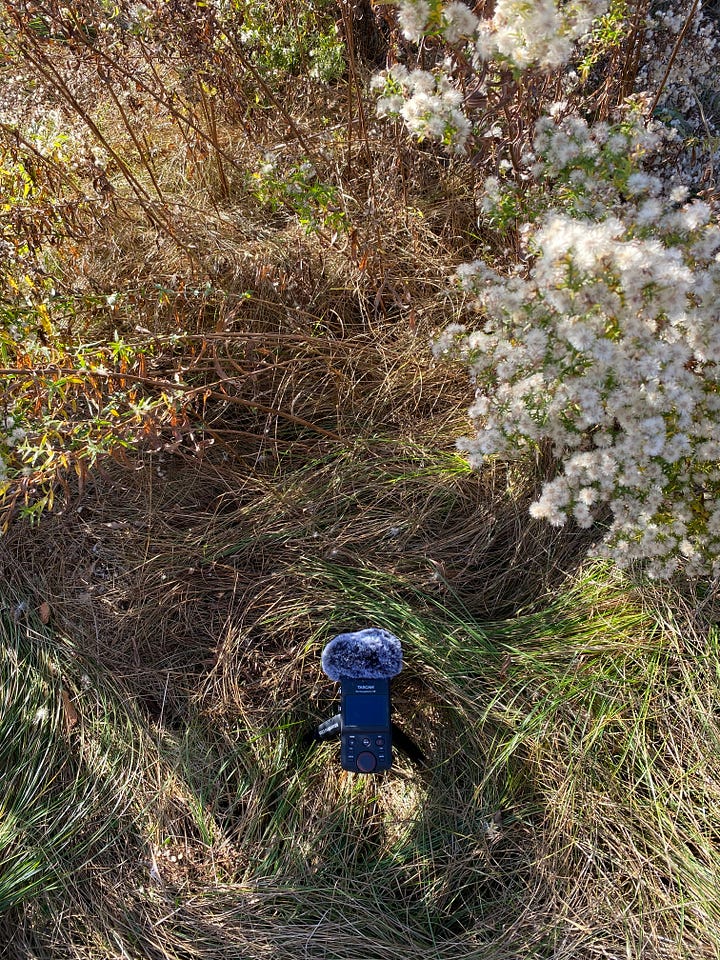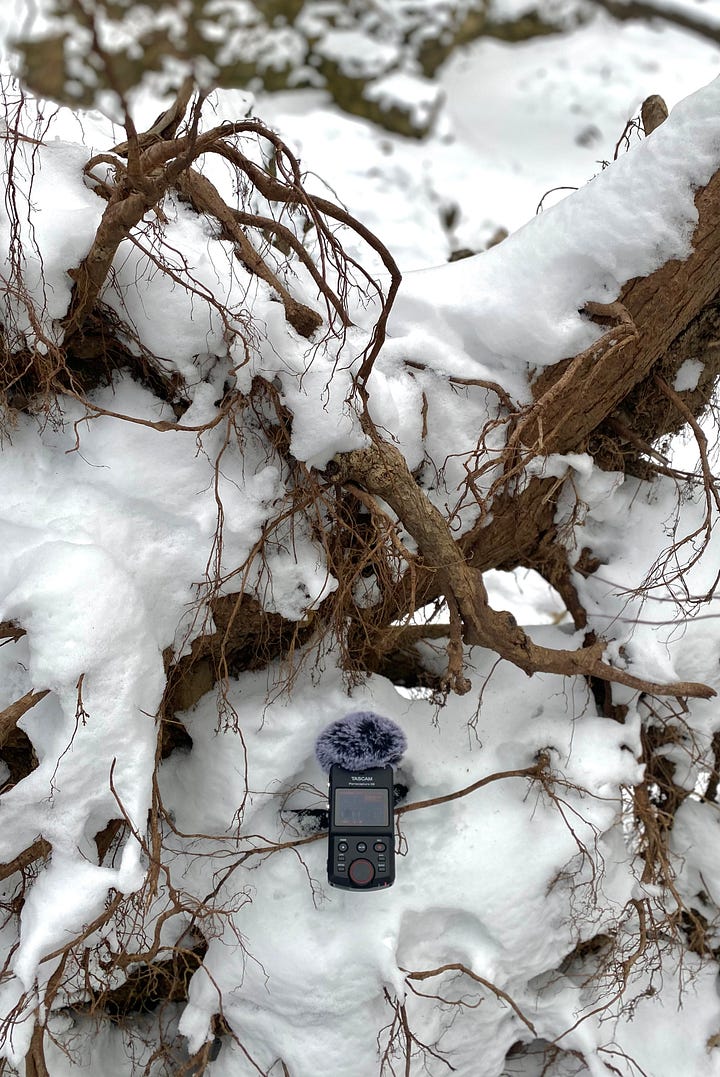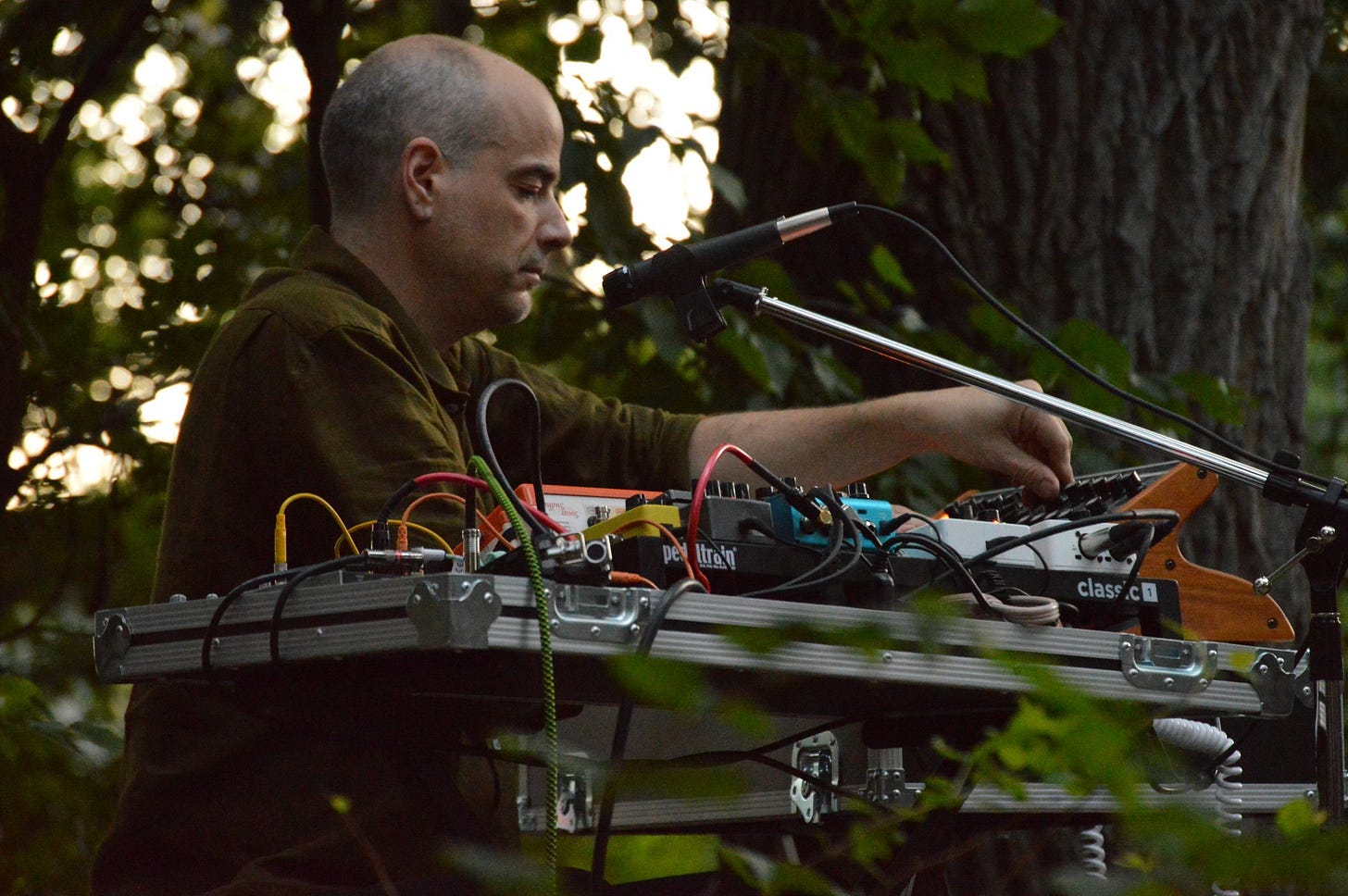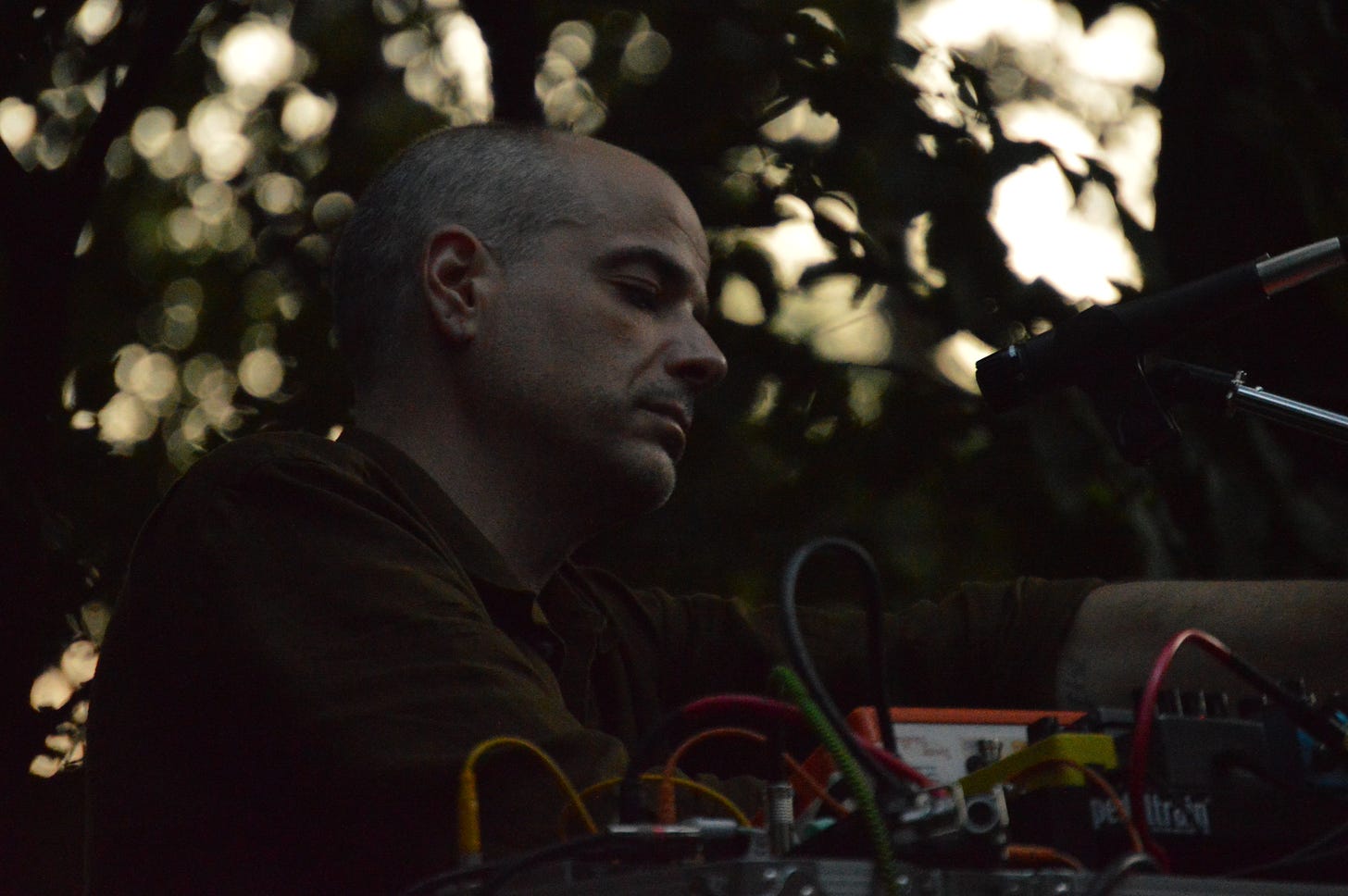Green Green Earth
Reflections, resonances and re-connection — a moment with artist Matthew Hiram
“How do you capture the luminous glow of sunlight beneath a living leaf?”
With a koan-like simplicity, Matthew Hiram aka Hiram asks us this gentle question as a prefix to his latest collection of recordings titled Green Green Earth.
Inspired by that infinite kaleidoscopic shade, Green Green Earth offers a delicate answer with this collection of meditative vignettes — evoking the stillness of Nature, inviting connection, reflection, and wonder.
Recorded in the summer of 2024, the album draws from Hiram's intimate solo performances on voice, piano, organ, flute, and synthesizer, interlaced with organic field recordings that bring the outside world into focus — the whisper of wind through the trees, the rhythmic pulse of rain, and the chorus of birds and insects blending seamlessly with the resonant tones of bells, bowls, and chimes which craft rich, resonant soundscapes.
Each note feels suspended between Earth and sky, inviting quiet contemplation of humanity’s place within the delicate balance of Nature.
“This album is a meditation on the Earth we share, a small reminder to slow down and listen.”
I first connected with Matthew after discovering his works through a label that we both share a great fondness for — Aural Canyon. A deep listening universe that is home to both Matthew’s Air Songs and my first album Spirits & Reflections.
Part of what brings me great joy writing and curating Sonic Tapestries is the reading, listening and discovery of individuals who find harmony in adjoining the practice of field recording and the exploration of the soundscapes of Nature.
You can check out previous talks with artists including Mélia Roger, Gregor Vida and Emanuele Pertoldi below :
Matthew’s music invites connection with the natural world, offering a space for healing, reflection, and ecological awareness. Through immersive sound design, his work encourages listeners to pause, reflect, and contemplate the beauty and fragility of Earth.
I was fortunate enough to share a moment with Matthew to ask him a few questions about his work, his recordings and his studio practice…
Hey Matthew — thanks so much for taking the time to contribute your time to Sonic Tapestries!
I’d like to start by asking you about your new collection Green Green Earth — just released today — can you tell us a little about what inspired it’s creation and the process of piecing together your soundscapes?
Hey Mat! Thank you again for this opportunity. I'm a fan of your great work, and so appreciate your understanding and support of my music!
I wanted to make music that captured those feelings of entering a shaded grove, of sunlight reflecting through leaves, and looking down through the trees. It’s moments like that, the magic of escaping and feeling connected simultaneously, that inspired the album.
Walking into a place like the Eloise Butler Bird Sanctuary is such an awesome, uplifting experience. You wind down into the green and the whole feeling changes. I love how the light shifts, the trees create their own sense of space, and the subtle sounds of the canopy just carry across every moment. That feeling is a core element.
Exploring the incredible ancient Redwood Forests recently in Northern California really brought a great sense of awestruck humility for me, and helped bring the greater understanding and concept of the meaning of this album into focus. The album is meant to honor and preserve these green spaces, its music for connection and reflection.
The Golden Hour in Eloise Butler Bird Sanctuary (Stereo Mix) - 2:48
This field recording captures multiple layers of birdcall, and the sound of strong winds moving through the trees. Close listening reveals many details like insects in flight, and the distinct sound of pinecones occasionally falling to the forest floor. This field recording is featured in the track Viburnum (Green Green Earth)
So where did you record all these wonderful sounds?
The studio aspects of Green Green Earth were recorded in my home based Natural Sound Studio through the Summer of 2024. The album presents a series of meditative solo sessions for voice, synthesizer, flute and electronics. The album was made using a series of collected field recordings from bird sanctuaries, national forests, waterways and gardens, to bring the stories of these spaces into the textures of the work. The album was inspired by my love and connection to these sacred green spaces, and wanting to nurture and express that to share with people.
Could you tell us a little more about your studio — what equipment or software do you cherish most?
I use both electronic and acoustic instruments, and I really love that balance. I like the idea of having a broad range to pull from and work with, and I’m more of a hardware than a software guy, so I’ve accumulated a decent collection of instruments and gear over the years. It’s probably never ending… haha!!
I’ve currently got an upstairs and downstairs setup. Downstairs is the small, somewhat treated space, with Farfisa organ, electric piano, all the stringed instruments, percussion, bells, and the smaller synthesizers. Upstairs is the more “live” set up, like what I’d bring to a gig, where I’m using the Moog Sub-25 and microphone, with flutes and an effect board for signal processing.To tell you which element I cherish most is a tough one though… like picking a favorite child! A lot of what I’m doing in the studio is capturing these quiet, intimate performances. This isn’t meant to be a sponsorship, but I’ve been using the Audio-Technica AT4050 for live capture, and I really appreciate that microphone for delivering a clear, quality recording in a bunch of different applications. It gets a great transparent image of live performances, especially for resonant acoustic instruments, and it’s just an awesome mic for capturing these intimate scenarios that are a big part of my process.
Some of the most non-traditional kinds of studio stuff is the best, I think. Cheap and slightly broken gear always brings something interesting for me — like a little pink modified Walkman style tape machine I like to use, with a speed adjustment knob so I can dial things way down, and match pitch and tempo. I have a lot of tape machines, but that thing can just make the most far out, strangest sounds — it’s amazing how far you can push it!
“Often with my recordings, or beginning a new work, it’s coming from the idea of capturing an atmosphere, rather than a specific structure going in, so I try to be open to whatever happens in the atmosphere I’m working in.”
Say you were walking into your studio about to create something new —what is the first thing you reach for?
This varies day by day, but I always make a choice of restrictions first, by choosing my set up to get started. As I think about how to most accurately answer this question, I realize that my “go-to” instrument, for example the Walnut wooden bass flute that feels like an old friend, may not actually be the first thing I reach for.
If I’m coming in fresh, a lot of times I like to start with a field recording, a quiet shruti drone, or a gentle synth pattern to establish the frequencies we’re working with, and then expand from there. The first synth I would probably turn on today would be the Moog Sub-25, which has a great range and a dynamic, warm voice that I really like. Often with my recordings, or beginning a new work, it’s coming from the idea of capturing an atmosphere, rather than a specific structure going in, so I try to be open to whatever happens in the atmosphere I’m working in.


“ The idea of making eco-acoustic music means that it connects to, reflects and supports the environment, and the work is made to be in resonance with the sounds and frequencies of these natural spaces. ”
You describe your music as being eco-acoustic. What does this mean exactly?
There are probably multiple correct definitions of this idea. Eco-acoustics, or acoustic ecology, is the study of how sounds interact with the environment, including the role they play in ecological systems. There are highly skilled experts in this, and many ways we can use these sounds to better understand ecosystems, animal behavior, climate change, and actually hear the shifting sounds of our planet.
While eco-acoustics is understood to be a study, or scientific interpretation of these sounds, I use the term in describing my music to bring this idea into the frame of the arts. It reflects an expansion of my own musical electro-acoustic practice, and an acknowledgment of the shift to framing the environment itself as a collaborator and part of the creative force behind the work. So for me at least, the idea of making eco-acoustic music means that it connects to, reflects and supports the environment, and the work is made to be in resonance with the sounds and frequencies of these natural spaces.
Cicada calls from Minnehaha Creek (Cassette Loop Mono Mix) 3:13
This field recording was made to a twenty second tape loop via handheld cassette recorder. The recording captures the hypnotic waves of the Cicada’s insect call, with daytime birdsong, and an unfortunate, but telling “beep” audible from a driver locking their vehicle on the nearby roadway. While this feels conflicted in some ways, it’s the reality. An edit of this field recording is featured in the track Cicada Song (Green Green Earth)
When producing your music - do you use a lot of digital processing to create your sound or do you tend to keep things natural and organic?
I use both natural and digital elements in my process and try to strike a balance. I play real instruments, so capturing and retaining that natural, organic sound is essential, but all of these sounds are also processed in one way or another. I’m working to develop these deeply inward-focused dream-like spaces, so the layers, effects and spatial design are parts of how that comes together. I love exploring the spatial effects and depth of stereo, so in my recordings, I will often record two simultaneous tracks of the same thing. Sometimes it’s a stereo image of a single acoustic performance, and other times it would be one clean acoustic track, and one electronically processed version, and then make decisions in the mixing process for balancing what feels right. Often the final mix is close to 50/50, but some elements get pushed to ghostly levels. I like to make things feel dimensional and experiential, aiming for a dreamy ethereal quality, but retaining elements of reality and rooted in the Earthly realm.
Do you have a particular non-musical practice that helps to put you into the creative mindset for writing or recording?
I’d say number one is preparing the space. I am of the strong opinion that your surrounding atmosphere is a crucial element of fostering creative thought and productivity, and setting intention establishes the outcome. I would choose for no overhead lights, and if possible I like to have the work space clean and orderly, to minimize distractions. I will often choose for some source of open flame, like lighting a candle of some kind, and I have a few favorite types of incense that I find calming and pleasurable, to help clear the room and focus on the creative practice.
Beyond that, I would say that experiencing Nature really does bring me endless inspiration. That’s my primary activity that informs and fuels so much of what I do creatively. I had a very inspiring experience the other morning, walking around in the frozen woods and looking at moss on snow covered logs. I love finding these parallels in Nature and the human experience, it’s a great story of resilience and life against all odds that speaks on so many levels. Things like this really get me inspired and feeling ready to create.
Earth Speaks is a project of yours that seems to center on creating natural soundscapes from familiar environments close to you. What is your approach to field recording? Do you seek particular sounds out or do you record first and revisit later when listening back in the studio?
I am a Nature lover first. It’s a deep passion, and it’s always a centering thing for me to go out and connect to Nature and experience the beautiful outdoor spaces. So I do that as much as I possibly can, within reason. I use this idea of sonic conservation as a way to preserve and honor the sounds of these spaces, to document and bring them with me, and share them with the world. So it’s not that I seek particular sounds, but I’m always listening when I’m hiking or going to any beautiful natural space. There are so many people in the world, and we all have our own way of being here. Sound pollution is everywhere, so it feels extra precious when you get to some remarkable natural space, and the sounds of the space are so striking, it’s a huge part of how we experience the world. When it feels like there aren’t any interruptions or aspects of human influence, it’s just pure Nature and awesome, that’s so rare and magical!
When I go to these places, I’m usually moving quietly and listening, and sometimes just feel compelled to sit down to focus completely on listening. I made sure to always keep the recorder on hand, and when you experience a space with that pure sense of connection, and the sounds take over, those are the immersive and transportive moments I hope to capture with Earth Speaks.
Which artists or individuals have inspired you lately on your path?
Lately, I’ve been really inspired by the life of David Attenborough. I mean, what an incredible path he’s had — connecting people with the magic of Nature. The way he tells the stories about the planet feels so meaningful, and it makes me think about the privilege of being able to share something personal and connective in my own work.
I can recommend The Light Eaters by Zoë Schlanger ( you can read more about this excellent book in ’s wonderful Easy by Nature post ) which totally changed how I think about the natural world. The book dives into the many ways plants communicate through chemical signals, adaptability, and these intricate networks of connection. It’s fascinating and really got me reflecting on all the things that happen in Nature that we barely understand. That idea of unseen communication has definitely seeped into how I think about how I relate to the environment, and my relationship with sound and creating. I’ve always been drawn to artists who explore these deeper connections. It’s such a big part of why I create, and it keeps me inspired to keep listening and learning.
C. Lavender is an inspiration. Her book Transcendent Waves: How Listening Shapes Our Creative Lives is a thoughtful look at how we relate to sound and the act of listening, and her sound work is just unreal. Her recent album Rupture in The Eternal Realm is immersive in this way that makes you feel like you’re physically inside the sound, so intense. It really got me thinking about how sound shapes our experience of the world — it’s been so inspiring.
Brother Ah’s “Divine Music” is inspirational, the vision is so concise but expansive, like opening into a different dimension. I love the idea of developing a clearly defined musical world to step into. Michael A. Muller’s “Mirror Music” is another album I’ve been spending a lot of time with. It’s so elevated, just such a beautiful LP, atmospheric, thoughtful, and meditative in the best way. I also keep going back to the Cosmic Tones Research Trio’s “All Is Sound”. That album is perfect, and always feels like it’s revealing new layers, like it’s alive somehow. I’ve also been diving into a lot of classic Scientist dub mixes, they’re so brilliant and full of energy. Those productions have this incredible warmth and life that’s impossible to explain.
Aside from experimenting and exploring sound as an artist, I read that you are a certified Water Steward in Minneapolis? Can you tell us a little about what this role involves? Does it influence your creative output somewhat?
I committed to the role of Minnesota water steward to act as a voice of environmental conservation through advocacy in the arts. The Minnesota Water Steward initiative is a great program operated by Freshwater Society. They do a lot of important work in outreach, education and development around issues of water conservation. They also understand and support the idea that art can create conversation and impact change, so they have partnered with artists who support this message and can help build a conversation around environmental conservation and protection issues. I feel it’s my role to not just be inspired by the Earth, but to try to do something to help protect it.
In Summer of 2022, I participated in the training and was certified as an artist Minnesota Water Steward, to act as a creative voice to these issues. With support from the Freshwater Society and Hennepin County Environmental & Energy, a new work was commissioned, and the project culminated in the creation of Immersion, which premiered as an outdoor solo performance at Wood Lake Nature Center Amphitheater, and was created using sounds collected from Wood Lake and the surrounding landscape. The idea was to create a public arts experience to connect with people in a beautiful natural space, and use that experience to spread awareness to issues of conservation and protection.
The experience has helped deepen my commitment to the fact that art can impact change, and strengthen the idea of not just connecting to the themes and concepts of Nature, but to do my part as an artist to try to protect it. I continue to use themes of water in my work.
Daytime Thunderstorm in Bancroft Gardens (Stereo Mix) 4:44
This field recording captures the sounds of a daytime thunderstorm, with the sun shining as the storm rolled through. We hear shifting waves of rainfall, and water splashing as it comes to ground in nearby pools and puddles, with ominous thunder and the contrast of chirping bird song. This field recording is featured in the track Sacre.
Do you have any other upcoming projects or collaborations you are working on, things to expect coming up soon? How can folks find you and stay in touch?
I have been writing and finishing a new record with my duo Visible Light, collaborating with my partner Amy. We’re creating new chamber ambient music together, written for cello and flute, with quartz bowls and synthesizer. The music is based on themes of the seasons and cycles of Nature. It’s meditative and deep-listening focused, with timeless narratives woven into the compositions. We’ll be excited to announce more details on that project in the coming months…
I’ve got more new Hiram music in the finishing stages, titled “Solarium Songs”, for release later this year. These recordings are an extension of my work in botanical music and data-sonification techniques, using frequencies from living plants to create the music. The recordings were made in a period of preparation for a solo performance at the Wonder Valley Experimental Festival, and the album offers a pair of live extended sessions for immersive deep-listening.
I’ve got a few other fun surprises coming up too, to stay connected, you can subscribe to my Flow & Form Newsletter to keep up with the latest projects, and be the first to hear new music. BlueSky also seems great, so if folks are there, give a follow and say hi. Thanks for listening! 🙏🌿✨
For a deeper dive into Matthew Hiram’s music, explore the artist’s complete discography or visit the artist’s official Bandcamp site to discover more soundscapes and albums.
Sonic Tapestries is a reader-supported publication. To receive new posts and support my work, please consider becoming a free subscriber
Your kind support helps me to grow my audience and continue on my creative path.
If you do like reading along and want to help support my work further, please consider sharing this post with your friends, family and followers.
For a limited time only, you can upgrade to a paid subscription — which includes entry into my Album of the Month prize draw, an exclusive monthly audio goodie bag and one-on-one listening sessions by following the link below :
Thank you for being here with me.
Mat
🌻










